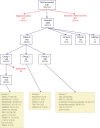Assessment of Type I Interferon Signaling in Pediatric Inflammatory Disease
- PMID: 27943079
- PMCID: PMC5325846
- DOI: 10.1007/s10875-016-0359-1
Assessment of Type I Interferon Signaling in Pediatric Inflammatory Disease
Abstract
Purpose: Increased type I interferon is considered relevant to the pathology of a number of monogenic and complex disorders spanning pediatric rheumatology, neurology, and dermatology. However, no test exists in routine clinical practice to identify enhanced interferon signaling, thus limiting the ability to diagnose and monitor treatment of these diseases. Here, we set out to investigate the use of an assay measuring the expression of a panel of interferon-stimulated genes (ISGs) in children affected by a range of inflammatory diseases.
Design, setting, and participants: A cohort study was conducted between 2011 and 2016 at the University of Manchester, UK, and the Institut Imagine, Paris, France. RNA PAXgene blood samples and clinical data were collected from controls and symptomatic patients with a genetically confirmed or clinically well-defined inflammatory phenotype. The expression of six ISGs was measured by quantitative polymerase chain reaction, and the median fold change was used to calculate an interferon score (IS) for each subject compared to a previously derived panel of 29 controls (where +2 SD of the control data, an IS of >2.466, is considered as abnormal). Results were correlated with genetic and clinical data.
Results: Nine hundred ninety-two samples were analyzed from 630 individuals comprising symptomatic patients across 24 inflammatory genotypes/phenotypes, unaffected heterozygous carriers, and controls. A consistent upregulation of ISG expression was seen in 13 monogenic conditions (455 samples, 265 patients; median IS 10.73, interquartile range (IQR) 5.90-18.41), juvenile systemic lupus erythematosus (78 samples, 55 patients; median IS 10.60, IQR 3.99-17.27), and juvenile dermatomyositis (101 samples, 59 patients; median IS 9.02, IQR 2.51-21.73) compared to controls (78 samples, 65 subjects; median IS 0.688, IQR 0.427-1.196), heterozygous mutation carriers (89 samples, 76 subjects; median IS 0.862, IQR 0.493-1.942), and individuals with non-molecularly defined autoinflammation (89 samples, 69 patients; median IS 1.07, IQR 0.491-3.74).
Conclusions and relevance: An assessment of six ISGs can be used to define a spectrum of inflammatory diseases related to enhanced type I interferon signaling. If future studies demonstrate that the IS is a reactive biomarker, this measure may prove useful both in the diagnosis and the assessment of treatment efficacy.
Keywords: Interferon; autoinflammation; autoinflammatory disease; interferonopathy.
Conflict of interest statement
The authors declare that they have no conflict of interest.
Figures




References
-
- Frémond ML, Rodero MP, Jeremiah N, et al. Efficacy of the Janus Kinase 1/2 Inhibitor Ruxolitinib in the Treatment of Vasculopathy Associated with TMEM173-Activating Mutations in three children. J Allergy Clin Immunol. 2016. - PubMed
MeSH terms
Substances
Grants and funding
LinkOut - more resources
Full Text Sources
Other Literature Sources

